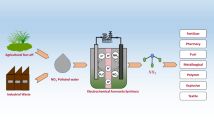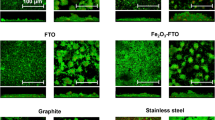Abstract
The thermo-acidophilic archaeon, Sulfolobus tokodaii, was utilized for the production of Pd(0) bionanoparticles from acidic Pd(II) solution. Use of active cells was essential to form well-dispersed Pd(0) nanoparticles located on the cell surface. The particle size could be manipulated by modifying the concentration of formate (as electron donor; e-donor) and by addition of enzymatic inhibitor (Cu2+) in the range of 14–63 nm mean size. Since robust Pd(II) reduction progressed in pre-grown S. tokodaii cells even in the presence of up to 500 mM Cl−, it was possible to conversely utilize the effect of Cl− to produce even finer and denser particles in the range of 8.7–15 nm mean size. This effect likely resulted from the increasing stability of anionic Pd(II)–chloride complex at elevated Cl− concentrations, eventually allowing involvement of greater number of initial Pd(0) crystal nucleation sites (enzymatic sites). The catalytic activity [evaluated based on Cr(VI) reduction reaction] of Pd(0) bionanoparticles of varying particle size formed under different conditions were compared. The finest Pd(0) bionanoparticles obtained at 50 mM Cl− (mean 8.7 nm; median 5.6 nm) exhibited the greatest specific Cr(VI) reduction rate, with four times higher catalytic activity compared to commercial Pd/C. The potential applicability of S. tokodaii cells in the recovery of highly catalytic Pd(0) nanoparticles from actual acidic chloride leachate was, thus, suggested.








Similar content being viewed by others
References
Barakat MA, Mahmoud MHH, Mahrous YS (2006) Recovery and separation of palladium from spent catalyst. Appl Catal A 301:182–186
Bunge M, Sobjerg LS, Rotaru AE, Gauthier D, Lindhardt AT, Hause G, Finster K, Kingshott P, Skrydstrup T, Meyer RL (2010) Formation of palladium(0) nanoparticles at microbial surfaces. Biotechnol Bioeng 107:206–215
Colombo C, Oates CJ, Monhemius AJ, Plant JA (2008) Complexation of platinum, palladium and rhodium with inorganic ligands in the environment. Geochem-Explor Env A 8:91–101
Creamer NJ, Baxter-Plant VS, Henderson J, Potter M, Macaskie LE (2006) Palladium and gold removal and recovery from precious metal solutions and electronic scrap leachates by Desulfovibrio desulfuricans. Biotechnol Lett 28:1475–1484
Creamer NJ, Mikheenko IP, Yong P, Deplanche K, Sanyahumbi D, Wood J, Pollmann K, Merroun M, Selenska-Pobell S, Macaskie LE (2007) Novel supported Pd hydrogenation bionanocatalyst for hybrid homogeneous/heterogeneous catalysis. Catal Today 128:80–87
De Corte S, Hennebel T, De Gusseme B, Verstraete W, Boon N (2012) Bio-palladium: from metal recovery to catalytic applications. Microb Biotechnol 5:5–17
De Windt W, Boon N, Van den Bulcke J, Rubberecht L, Prata F, Mast J, Hennebel T, Verstraete W (2006) Biological control of the size and reactivity of catalytic Pd(0) produced by Shewanella oneidensis. Antonie Van Leeuwenhoek 90:377–389
Deplanche K, Caldelari I, Mikheenko IP, Sargent F, Macaskie LE (2010) Involvement of hydrogenases in the formation of highly catalytic Pd(0) nanoparticles by bioreduction of Pd(II) using Escherichia coli mutant strains. Microbiol SGM 156:2630–2640
Deplanche K, Bennett JA, Mikheenko IP, Omajali J, Wells AS, Meadows RE, Wood J, Macaskie LE (2014) Catalytic activity of biomass-supported Pd nanoparticles: influence of the biological component in catalytic efficacy and potential application in ‘green’ synthesis of fine chemicals and pharmaceuticals. Appl Catal B 147:651–665
Foulkes JM, Deplanche K, Sargent F, Macaskie LE, Lloyd JR (2016) A novel aerobic mechanism for reductive palladium biomineralization and recovery by Escherichia coli. Geomicrobiol J 33:230–236
Giordano M, Kansiz M, Heraud P, Beardall J, Wood B, McNaughton D (2001) Fourier transform infrared spectroscopy as a novel tool to investigate changes in intracellular macromolecular pools in the marine microalga Chaetoceros muellerii (bacillariophyceae). J Phycol 37:271–279
Goormaghtigh E, Cabiaux V, Ruysschaert J (1994) Determination of soluble and membrane protein structure by Fourier transform infrared spectroscopy: I. Assignments and model compounds. In: Hilderson HJ, Ralston GB (eds) Subcellular biochemistry. Physicochemical methods in the study of biomembranes. Springer, Boston, pp 329–362
Humphries AC, Penfold DW, Macaskie LE (2007) Cr(VI) reduction by bio and bioinorganic catalysis via use of bio-H2: a sustainable approach for remediation of wastes. J Chem Technol Biotechnol 82:182–189
Kalabegishvili TL, Murusidze IG, Prangishvili DA, Kvachadze LI, Kirkesali EI, Rcheulishvili AN, Ginturi EN, Janjalia MB, Tsertsvadze GI, Gabunia VM, Frontasyeva MV, Zinicovscaia I, Pavlov SS (2014) Gold nanoparticles in Sulfolobus islandicus biomass for technological applications. Adv Sci Eng Med 6:1–7
Kalabegishvili TL, Murusidze IG, Prangishvili DA, Kvachadze LI, Kirkesali EI, Rcheulishvili AN, Ginturi EN, Janjalia MB, Tsertsvadze GI, Gabunia VM, Frontasyeva MV, Zinicovscaia I, Pavlov SS (2015) Silver nanoparticles in Sulfolobus islandicus biomass for technological applications. Adv Sci Eng Med 7:1–8
Koerdt A, Orell A, Pham TK, Mukherjee J, Wlodkowski A, Karunakaran E, Biggs CA, Wright PC, Albers S (2011) Macromolecular fingerprinting of Sulfolobus species in biofilm: a transcriptomic and proteomic approach combined with spectroscopic analysis. J Proteome Res 10:4105–4119
Mabbett AN, Yong P, Farr JP, Macaskie LE (2004) Reduction of Cr(VI) by “palladized” biomass of Desulfovibrio desulfuricans ATCC 29577. Biotechnol Bioeng 87:104–109
Mabbett AN, Sanyahumbi D, Yong P, Macaskie LE (2006) Biorecovered precious metals from industrial wastes: single-step conversion of a mixed metal liquid waste to a bioinorganic catalyst with environmental application. Environ Sci Technol 40:1015–1021
Masaki Y, Tsutsumi K, Okibe N (2018) Iron redox transformation by the thermo-acidophilic archaea from the genus Sulfolobus. Geomicrobiol J 35:757–767
Mertens B, Blothe C, Windey K, De Windt W, Verstraete W (2007) Biocatalytic dechlorination of lindane by nano-scale particles of Pd(0) deposited on Shewanella oneidensis. Chemosphere 66:99–105
Mikheenko IP, Rousset M, Dementin S, Macaskie LE (2008) Bioaccumulation of palladium by Desulfovibrio fructosivorans wild-type and hydrogenase-deficient strains. Appl Environ Microbiol 74:6144–6146
Mizuno K, Miyatani G (1976) Successive spectrophotometric determination of palladium and platinum. Bull Chem Soc Jpn 49:2479–2480
Nalajala N, Chakraborty A, Bera B, Neergat M (2016) Chloride (Cl−) ion-mediated shape control of palladium nanoparticles. Nanotechnology 27:065603
Noroozifar M, Khorasani-Motlagh M (2003) Specific extraction of chromium as tetrabutylammonium-chromate and spectrophotometric determination by diphenylcarbazide: speciation of chromium in effluent streams. Anal Sci 19:705–708
Okibe N, Nakayama D, Matsumoto T (2017) Palladium bionanoparticles production from acidic Pd(II) solutions and spent catalyst leachate using acidophilic Fe(III)-reducing bacteria. Extremophiles 21:1091–1100
Rizki IN, Okibe N (2018) Size-controlled production of gold bionanoparticles using the extremely acidophilic fe(iii)-reducing bacterium. Acidocella aromatica. Miner 8:3
Sinha P, Roy S, Das D (2015) Role of formate hydrogen lyase complex in hydrogen production in facultative anaerobes. Int J Hydrog Energy 40:8806–8815
Sleytr UB, Beveridge TJ (1999) Bacterial S-layers. Trends Microbiol 7:253–260
Suzuki T, Iwasaki T, Uzawa T, Hara K, Nemoto N, Kon T, Ueki T, Yamagishi A, Oshima T (2002) Sulfolobus tokodaii sp. nov. (f. Sulfolobus sp. strain 7), a new member of the genus Sulfolobus isolated from Beppu Hot Springs, Japan. Extremophiles 6:39–44
Yang G, Bauer TJ, Haller GL, Baráth E (2018) H-transfer reactions of internal alkenes with tertiary amines as H-donors on carbon supported noble metals. Org Biomol Chem 16:1172–1177
Yates MD, Cusick RD, Logan BE (2013) Extracellular palladium nanoparticle production using Geobacter sulfurreducens. Acs Sustain Chem Eng 1:1165–1171
Yong P, Rowson NA, Farr JP, Harris IR, Macaskie LE (2002) Bioreduction and biocrystallization of palladium by Desulfovibrio desulfuricans NCIMB 8307. Biotechnol Bioeng 80:369–379
Zhang XL, Yan S, Tyagi RD, Surampalli RY (2011) Synthesis of nanoparticles by microorganisms and their application in enhancing microbiological reaction rates. Chemosphere 82:489–494
Zhang R, Neu TR, Zhang Y, Bellenberg S, Kuhlicke U, Li Q, Sand W, Vera M (2015) Visualization and analysis of EPS glycoconjugates of the thermoacidophilic archaeon Sulfolobus metallicus. Appl Microbiol Biotechnol 99:7343–7356
Zhao L, Jiang D, Cai Y, Ji X, Xie R, Yang W (2012) Tuning the size of gold nanoparticles in the citrate reduction by chloride ions. Nanoscale 4:5071
Acknowledgement
This work was partly supported by a grant from the Japan Society for the Promotion of Science (JSPS Kakenhi No. 26820394). We are grateful to Dr Yumi Fukunaga at the Ultramicroscopy Research Center, Kyushu University, for her support in TEM analysis. S.K. is grateful for financial assistance provided by the Kyushu University Advanced Graduated Program in Global Strategy for Green Asia.
Author information
Authors and Affiliations
Corresponding author
Additional information
Communicated by G. Antranikian.
Publisher's Note
Springer Nature remains neutral with regard to jurisdictional claims in published maps and institutional affiliations.
Electronic supplementary material
Below is the link to the electronic supplementary material.
Supplementary material 1 (PDF 1379 kb). SEM image of Pd(0) precipitates formed in cell-free controls
792_2019_1106_MOESM3_ESM.pdf
Supplementary material 3 (PDF 247 kb). Comparison of the catalytic activity (based on the specific Cr(VI) reduction rate) of Pd(0) bionanoparticles (a–h) and commercial Pd/C catalyst (i). Pd(0) bionanoparticles were produced by S. tokodaii in the presence of either 5 mM formate (a–d) or 10 mM formate (e–h), under different conditions: (a) active cells, (b) active cells + Cu2+, (c) heat-killed cells, (d) cell-free controls, (e) active cells, (f) active cells + 10 mM Cl−, (g) active cells + 50 mM Cl−, and (h) active cells + 100 mM Cl−. The specific Cr(IV) reduction rates in Fig. 8 were calculated for the time interval of 0–5 h (a), 0–30 h (b), 0–30 h (c), 0–48 h (d), 0–10 h (e), 0–9 h (f), 0–1 h (g), 0–4 h (h), and 0–4 h (i). As e-donor for Cr(VI) reduction, 10 mM formate was used in all cases
Rights and permissions
About this article
Cite this article
Kitjanukit, S., Sasaki, K. & Okibe, N. Production of highly catalytic, archaeal Pd(0) bionanoparticles using Sulfolobus tokodaii. Extremophiles 23, 549–556 (2019). https://doi.org/10.1007/s00792-019-01106-7
Received:
Accepted:
Published:
Issue Date:
DOI: https://doi.org/10.1007/s00792-019-01106-7




